Tidal Fraser River Fall Salmon Fishery
By Rodney Hsu, Fishing with Rod | Published in October 2010
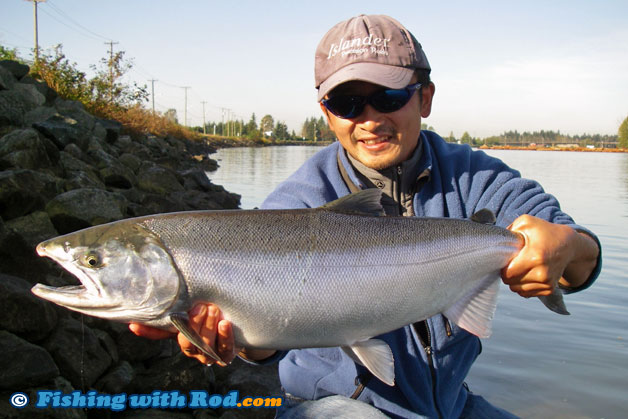
Each year, Tidal Fraser River's fall salmon fishery starts in early October after DFO's Interior coho salmon management measures end. The fishery lasts for up to two months until all chinook, coho and chum salmon return to their Lower Fraser River tributaries. It is a convenient, relaxing and sometimes productive fishery which is ideal for families. This comprehensive guide is designed to assist those who are new to this fishery so they can have a chance to enjoy by learning the techniques, staying informed on regulations and etiquettes.
Fish Species & Regulations
Three salmon species are primarily targeted in this fishery. They are chinook, coho and chum salmon. These fish are returning to tributaries of the Lower Fraser River such as Chilliwack, Stave, Harrison River to spawn.
Beside salmon, it is also not unusual to encounter both cutthroat trout and bull trout when participating in this fishery. All wild/unmarked (fish that have an adipose fin) trout have to be released.
The salmon regulations of Tidal Fraser River and daily quota of each salmon species can be found on this page in the Tidal Water Fishing Regulations. You can only keep FOUR salmon in total per day, which means if you keep four chum salmon, you can no longer keep any other salmon species.
| Species | Average size | Best fishing time |
|---|---|---|
| Chinook salmon | 5 - 30lb | early October - mid October |
| Coho salmon | 2 - 15lb | early October - early December |
| Chum salmon | 5 - 15lb | mid October - early December |
| Coastal cutthroat trout | 0.5 - 2lb | late September - early November |
| Bull trout | 1 - 6lb | early October - late November |
Salmon Identification
Because there are both species that you can keep and cannot keep in the Tidal Fraser River at the same time, it is important to know how to identify them.
Chinook salmon
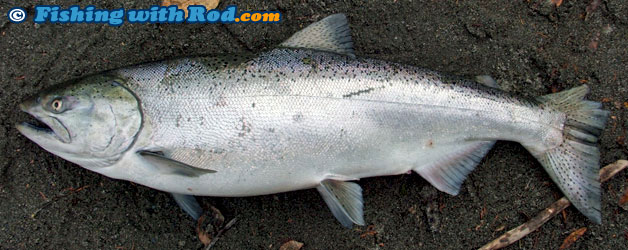
Chinook salmon have small spots across their back and small spots across their entire tail. Their gum is black and the edge of their jaw is white. All chinook salmon caught (jacks included) in tidal waters are required to be recorded on your tidal water fishing licence immediately once the fish is dispatched.
Coho salmon
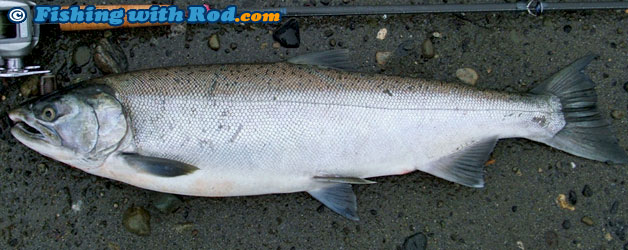
Coho salmon have small spots across their back and spots on the top portion of their tail. Their gum is white. Two groups of coho salmon are found in this fishery - Wild and hatchery marked fish. Hatchery marked fish, which anglers are allowed to keep, do not have an adipose fin. Instead, they have a healed scar where the adipose fin would be. This fin is clipped at the hatchery when they are at their juvenile stage prior to being released. If an adipose fin is present, then it is a wild fish, which is required to be released with care.
Chum salmon
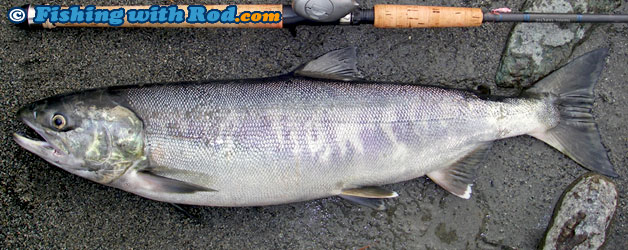
Chum salmon have two distinct characteristics, which are colourful (purple, pink, red, brown) stripes across their green/olive body and large teeth found on males.
Trout and Char Identification
Two species of trout and char can be found in the Tidal Fraser River, especially during fall months when they follow salmon back to rivers. Majority of these fish are not hatchery raised, so they are required to be released.
Coastal cutthroat trout
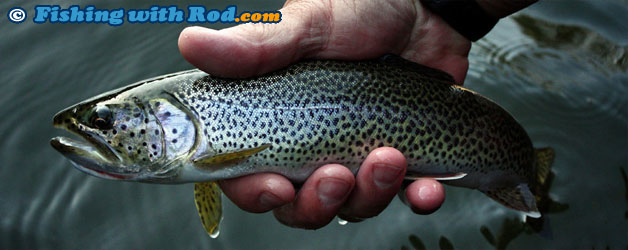
Weighing less than 2 pounds, coastal cutthroat trout can often be confused with coho jacks especially in the estuaries where they lose most of their freshwater characteristics. In rivers and lakes, coastal cutthroat trout are very spotty from the back to the abdomen and have somewhat of a darker body colouration. In estuaries, they are still very spotty across their entire body but their body tends to be very silver. The easiest way to identify them is by looking for a orange/red lining that is located below their gill plates. Compared to a coho jack, cutthroat trout are generally slimmer.
Bull trout
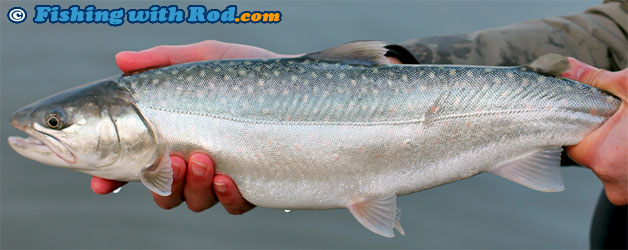
Bull trout belong in the char family, which are closely related to trout. They are much easier to identify due to a few distinct characteristics. Look for the white spots across the back. Pink spots can also be found along the lateral line. The size of a bull trout found in the Tidal Fraser River can vary, from less than 1 pound to 10 pound.
Common Fishing Techniques
There are several techniques that you can use when targeting fall salmon in the Tidal Fraser River. One can bottom fish with roe (plunking), cast artificial lures or fly fish.
Gear requirement
| Rod: | 8' to 10'6" baitcasting or spinning rod, rated between 8 and 15lb |
| Reel: | Small baitcasting reel or medium size spinning reel |
| Main line: | 8 to 15lb test |
| Leader: | 8 to 12lb test |
| Hook: | Size 1/0 or 2/0 |
Bottom fishing with roe
This technique is only permitted when there is not a bait ban on the Fraser River. Bottom fishing with roe is always relaxing yet exciting at times when the bite is on, so anyone can take part in it. Beside your rod and reel, it is best to have a rod holder, a chair and warm drinks with you.
The setup is fairly simple, a three-way swivel is tied onto the main line and additional lines are tied onto the other two ends. On one end, tie a 1 foot long leader for the hook, while a 2 feet long line is tied onto the other for the weight. The amount of weight used depends on the strength of the tidal current. 1oz or more is often needed. You want to use enough weight so it would anchor on the bottom. Because abrasion on the line can often happen when bottom fishing, it is best to use line that is rated 12lb test or more. Your hook size should be 1/0 or 2/0, so it can hold enough bait and prevent hooking a fish too deeply.
Freshly cured roe, which can be bought at your local tackle store, should be used. Dew worm is also a good alternative. The size of your bait on the hook should be enough to cover the hook but not too much, otherwise you would end up feeding fish rather than catching them.
Once you have casted your baited rig out, place the rod on the holder and tighten the line. Wait for bites that can happen anytime so be sure to keep your eyes on the rod tip. When bites take place, gently hold the rod up to detect them and set the hook decisively rather than randomly yanking the rod.
Lure fishing
Lure fishing allows the angler to be mobile. Rather than waiting for fish to be attracted to your bait, you can cast and retrieve at different spots to cover the river systematically.
A spinning rod is more suitable for this technique. To achieve the furthest casting distance, try using 8lb or 10lb test for your main line. Commonly used lures are spoons and spinners that weigh between 1/8 and 3/8oz. Colours that seem to work best are orange, pink and green.
Once casting your lure out, allow it to sink for a few seconds before beginning your retrieve. Your retrieve speed should be slow enough for fish to chase down but fast enough so the lure can be kept away from snags. This speed can be determined after experimenting with different retrieve rate. Point your rod tip at the water to give your lure the best swimming action. A twitch or two at times can often trigger a bite.
You should always be attentive to your lure until it is out of the water. Too often both salmon and trout would chase your lure to shore. If not paying attention, a last second strike can lead to the line snapping.
Fly fishing
Fly fishing is also possible in the Tidal Fraser River. While most shorelines of this section of the Fraser River are lined with a busy road, there are spots where adequate backcasting space is available.
For salmon, a 6/7wt fly fishing rod is required. Depending on water depth, either a floating line or intermediate sink line can be used. Typical salmon streamers in size 6 to 1 should be used, depending on the water clarity. The technique is similar to lure fishing, simply cast, allow your presentation to sink and retrieve by stripping in your line at short intervals.
If you miss a bite, continue stripping the line because quite often fish will return for a second or third attack. Fly fishing is advantageous in situations when you need to slow your presentation down for fish to find it.
Additional notes
I am often asked where are the best spots to target salmon on the Tidal Fraser River. There are no easy answers to this question. Because returning salmon will pass every spot on the Fraser River, you can essentially do well at any particular spot as long as there are fish moving through. The key point to focus on is not necessarily the best fishing spot, rather the best timing for one particular spot. To do so, experiment with fishing a spot during different tides. Sometimes a spot is better during the incoming tide while another spot may produce better during the outgoing tide.
The tide plays a big role in this fishery. Most salmon enter the river during the incoming tide so the last two hours before the tide peaks usually result in the best fishing. That being said, the beginning of outgoing tide can also be fantastic at times.
Bring a landing net with a soft net mesh. Because you are targeting both fish that you can either keep or have to release, a catch and release landing net allows you to handle each fish in the least harmful manner. The landing net is also a safety feature. Some fishing spots are lined with slippery rocks, so netting a fish is a lot safer than trying to handle it by hands while worrying about falling.
You should also note that a single-point, barbless hook must be used in this fishery, but you can use up to two of them on the line (for example, two baited hooks, two lures, or two flies). Although allowed, it is best to use one hook on the line to avoid tangling or missing bites.
Finally, don't be afraid to ask others nearby if you have questions. Many anglers who take part in this fishery are veterans who have many seasons under their belt. Most are glad to assist newcomers. This is a social fishery, so it is quite common for regular fishers who frequently fish the same spots to become good friends.

